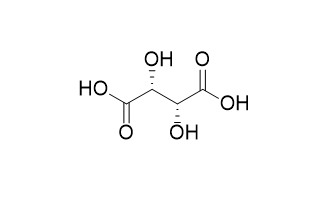L-(+)-Tartaric acid
Reference standards.
Inquire / Order:
manager@chemfaces.com
Technical Inquiries:
service@chemfaces.com
Tel:
+86-27-84237783
Fax:
+86-27-84254680
Address:
1 Building, No. 83, CheCheng Rd., Wuhan Economic and Technological Development Zone, Wuhan, Hubei 430056, PRC
Providing storage is as stated on the product vial and the vial is kept tightly sealed, the product can be stored for up to
24 months(2-8C).
Wherever possible, you should prepare and use solutions on the same day. However, if you need to make up stock solutions in advance, we recommend that you store the solution as aliquots in tightly sealed vials at -20C. Generally, these will be useable for up to two weeks. Before use, and prior to opening the vial we recommend that you allow your product to equilibrate to room temperature for at least 1 hour.
Need more advice on solubility, usage and handling? Please email to: service@chemfaces.com
The packaging of the product may have turned upside down during transportation, resulting in the natural compounds adhering to the neck or cap of the vial. take the vial out of its packaging and gently shake to let the compounds fall to the bottom of the vial. for liquid products, centrifuge at 200-500 RPM to gather the liquid at the bottom of the vial. try to avoid loss or contamination during handling.
Korean J. Medicinal Crop Sci.2021, 29(6):425-433
Postharvest Biol Tec2019, 149:18-26
Int J Mol Sci.2015, 16(8):18396-411
Phytomedicine2022, 104:154318
Biochem Biophys Res Commun.2017, 482(4):1095-1101
Horticulturae2022, 8(10), 975.
LWT2021, 147:111620.
Food Chem.2019, 279:80-87
Chem Res Toxicol.2023, 36(2):213-229.
J Cell Mol Med.2023, jcmm.18071.
Related and Featured Products
Masca research papers in science & archaeology, 1990.
Drink and be merry! Infrared spectroscopy and ancient Near Eastern wine。[Reference:
WebLink]
The first published chemical evidence for wine from the ancient Middle East is presented here.
METHODS AND RESULTS:
Infrared spectroscopic analyses of deposits inside pre-Bronze Age jars from Godin Tepe, Iran, and inside a Byzantine amphora from Gebel Adda, Egypt, revealed that the deposits were composed largely of tartaric acid, a principal component of grapes. The data corroborate the use of the Egyptian amphora in transporting wine, according to ancient inscriptions on the sides of such vessels. The very close similarity of the Godin Tepe spectra to that of the Egyptian amphora and that of L-(+)-Tartaric acid indicates that the Godin Tepe jars also were used in processing and storing wine. Moreover, the Godin jars were stoppered and stored on their sides, evidently to inhibit the wine from converting to vinegar.
In addition to being the earliest occurrence of the beverage from anywhere in the world, the Godin Tepe finding has important implications for the development of complex societies, trade, and viticulture in the ancient Middle East.



